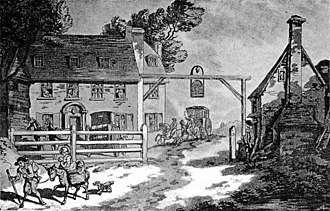Coaching inn
The coaching inn (also coaching house or staging inn) was a vital part of Europe's inland transport infrastructure until the development of the railway, providing a resting point for people and horses. The inn served the needs of travellers, for food, drink, and rest. The attached stables, staffed by hostlers, cared for the horses, including changing a tired team for a fresh one. Coaching inns were used by private travellers in their coaches, the public riding stagecoaches between one town and another, and (in England at least) the mail coach. Just as with roadhouses in other countries, although many survive, and some still offer overnight accommodation, in general coaching inns have lost their original function and now operate as ordinary pubs.

Description
Coaching inns stabled teams of horses for stagecoaches and mail coaches and replaced tired teams with fresh teams. Traditionally they were seven miles apart but this depended very much on the terrain. Some English towns had as many as ten such inns and rivalry between them was intense, not only for the income from the stagecoach operators but for the revenue for food and drink supplied to the passengers. Barnet, Hertfordshire still has an unusually high number of historic pubs along its high street due to its former position on the Great North Road from London to the North of England.
Historic inns

There were many coaching inns in what is now central London. The only remaining one with the galleries to the bedrooms above is The George Inn, Southwark, owned by the National Trust and still run as a pub. Many have been demolished and plaques mark their location. The Nomura building close to the Museum of London on London Wall commemorates the "Bull and Mouth" Inn; Golden Cross House, opposite St Martin's in the Fields recalls the Golden Cross, Charing Cross coaching inn.
Historic inns in Oxford include The Bear Inn (originally established in 1242) and the Lamb & Flag.
Those in Wales include the Black Boy Inn (built 1522) and the Groes Inn (1573).[3] The Black Lion in Cardigan (established 1105) is probably the oldest Welsh coaching inn.[4]
Cock and Bull

A pair of coaching inns on Watling Street are said to have given rise to the term "cock and bull stories." Coaches stopped in Stony Stratford as they made their way along the old Roman road from London to the North, and many a traveller's tall tale would be further embellished as it passed between the two hostelries, "The Cock" and "The Bull", fuelled by ale and an interested audience. Hence any suspiciously elaborate tale would become a cock and bull story.
This is a cock and bull story in itself, however; as there is no evidence to suggest that this is where the phrase originated.[5] The phrase, first recorded in 1621, may instead be an allusion to Aesop's fables, with their incredible talking animals.[6] As this slightly predates coaching inns, the names of the two inns could have been a reference to "Cock and Bull stories" as to encourage the passing of such anecdotes within their doors.
References
- Charles Harper (1922), The Brighton Road, Cecil Palmer, pp. 158–159
- "pubs.com - pubs Resources and Information". Pubs.com. Retrieved 2015-10-24.
- "Hotels in North Wales - Dog Friendly Conwy Hotels - The Groes Inn". The Groes Inn. Retrieved 2015-10-24.
- Archived April 13, 2012, at the Wayback Machine
- "World Wide Words: Cock and bull story". World Wide Words. Retrieved 2015-10-24.
- "Online Etymology Dictionary". Etymonline.com. Retrieved 2015-10-24.
Bibliography
- Coaching Era, The: Stage and Mail Coach Travel in and Around Bath, Bristol and Somerset, Roy Gallop, Fiducia (2003), ISBN 1-85026-019-2
'The English Urban Inn 1560-1750', Alan Everitt, in Perspectives in English Urban History, ed. By Alan Everitt, Palgrave Macmillan (1973), {{ISBN 978-1-349-00577-2 I}}
External links
- Coaching inns. By Anne Woodley.
- Stagecoaches and Coaching Inns. Cottontown.
- Photos of examples of what may be considered coaching inns in geograph.org.uk